This article dives into the different types of mands that can really boost communication skills in children, especially those with autism. By teaching kids to express their needs through various forms of requests—like verbal, non-verbal, sign language, and visual supports such as PECS—caregivers can make a huge difference in their communication abilities. Not only does this help reduce frustration, but it also encourages independence and better social interactions.
Imagine a child who can finally ask for their favorite toy or express when they’re feeling overwhelmed. It’s a game changer! By using these different methods, parents can create a more supportive environment that fosters connection and understanding. Let’s explore this together and see how these strategies can transform communication at home!
Understanding how children communicate their needs is so important, especially for those on the autism spectrum. Mands, or requests made by children, lay the groundwork for effective communication. They help kids express their desires and seek assistance in a meaningful way. In this article, we’ll explore ten distinct types of mands that can really boost a child's communication skills. We want to offer parents and caregivers some valuable strategies to foster independence and reduce frustration.
But what happens when traditional methods just don’t cut it? How can caregivers adapt their approaches to ensure every child finds their voice in a world that often overlooks their unique communication needs? Let’s dive into this together! We’re here to help you every step of the way!
At Rori Care, we know how important it is for kids to express their needs and wishes. That’s why our ABA Therapy incorporates extensive training methods for various types of mands. Understanding the types of mands, which are simply requests made by children to get what they want or need, is key to effective communication.
Imagine your child asking for a snack instead of grabbing or hitting—this is where mand training shines! By equipping caregivers with the right tools and knowledge, we help create a nurturing environment that supports your child’s behavioral goals. Our organized sessions blend play with naturalistic instruction, making it easier for clinicians to guide kids in asking for items, activities, or help.
This approach not only boosts interaction skills but also promotes independence, allowing children to engage more meaningfully with their surroundings and caregivers. Plus, by systematically teaching types of mands, we help reduce frustration and those challenging behaviors, paving the way for a more fulfilling communication experience for children with autism.
When a young learner successfully uses a mand, we provide prompt reinforcement, creating a strong link between their behavior and the reward. We encourage parents to practice mand training in everyday situations—like motivating their child to ask for a snack. This simple shift can significantly cut down on disruptive behaviors!
And here’s something important: ABA therapy is the only scientifically proven treatment for autism that’s covered by insurance. This means families can access effective support without the added stress of financial burden. Let’s explore this together and make a positive change for your child!
Verbal mands are super important when it comes to helping our little ones use spoken language to make requests. In ABA therapy, clinicians often use modeling and prompting techniques to encourage kids to vocalize their needs. For instance, if a child points to a toy, the therapist might ask, 'What do you want?' This simple prompt encourages the child to express their request verbally.
Reinforcement plays a key role in this process. When a child successfully uses a verbal request, giving them immediate positive feedback or access to the toy they want really strengthens that behavior. This not only encourages more verbal interaction but also helps reduce frustration. Studies show that effective prompting and reinforcement can significantly improve interaction skills, leading to better social exchanges for children with autism.
Additionally, discrete trial training (DTT) is often used to teach requests by breaking skills down into manageable steps. Understanding the various types of mands, such as item mands, action mands, location mands, and person mands, can significantly aid in developing effective communication strategies.
Qualified behavior analysts play a crucial role in this journey. They create personalized plans that include measurable objectives and evidence-based strategies tailored to each child's unique needs. This patient-centered approach ensures that therapy adapts to what each individual requires, fostering positive behavior changes and skill acquisition.
As one expert noted, 'The aim of instructing requests is to equip individuals with the resources they need to communicate effectively, thus minimizing frustration and the chances of problem behaviors like tantrums.' Plus, when caregivers are equipped with ABA principles and strategies, they can actively support their child's behavioral goals. This involvement leads to better outcomes for everyone involved.
So, let’s explore this together! We’re here to help you every step of the way!
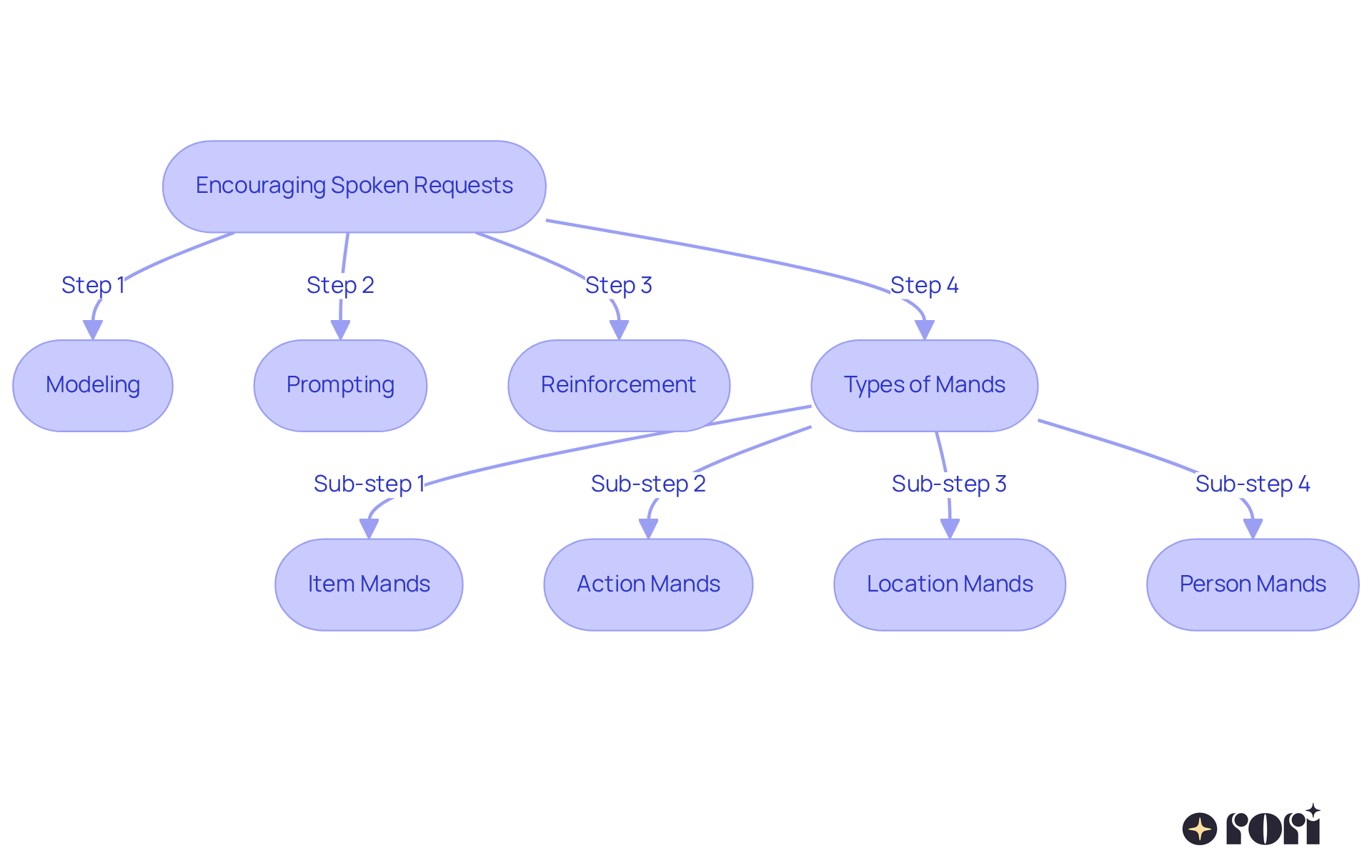
Non-verbal requests are super important for kids who have a tough time with verbal communication. These can show up as gestures, body language, or even facial expressions. For example, a little one might reach for a snack or nod toward a toy they want, signaling their needs without saying a word. Did you know that about 25-30% of kids with autism spectrum disorder are minimally verbal? This really highlights how crucial it is to have other ways to communicate.
ABA therapists play a key role in helping kids use these non-verbal cues effectively. By encouraging gestures and body language in the right situations, therapists help kids build a richer way to express themselves. Research shows that kids who go through non-verbal mand training can really boost their initiation and response rates. One young participant even jumped from making independent requests 12% of the time to an impressive 63% during the intervention!
Caregivers are vital in this journey, too. When they recognize and respond to these non-verbal requests, it not only keeps the child engaged but also builds their confidence in expressing their needs. Incorporating gestures and body language into types of mands training is essential, as it helps kids communicate better and prepares them for more complex interactions as they grow. Plus, joining social skills group therapy with trained therapists can really enhance these interpersonal skills, giving kids a chance to practice in a supportive environment.
Through caregiver education, families can learn valuable ABA principles that empower them to make informed choices, provide better support, and actively contribute to their child’s growth and behavioral goals. Let’s explore this together! We’re here to help you every step of the way!
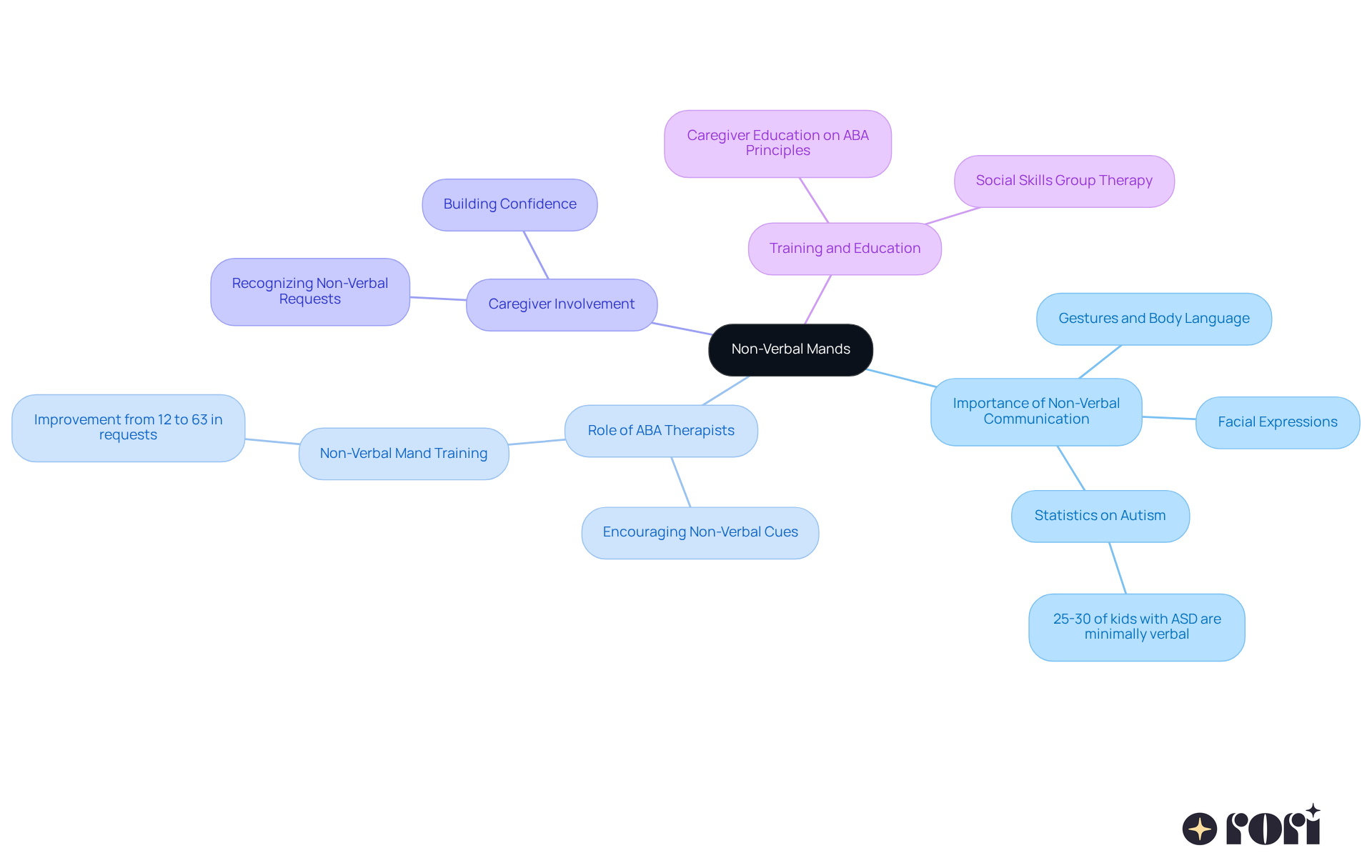
Sign language is one of the essential types of mands for non-verbal kids! They really help these little ones express their needs effectively. By teaching children the types of mands through simple signs for common requests—such as 'more,' 'help,' or 'eat'—they can express what they want without relying solely on verbal skills. Isn’t that amazing?
ABA therapists often weave sign language into their sessions, using visual aids and consistent reinforcement to make learning fun and effective. This patient-focused approach is all about adjusting to each child's unique needs, tapping into the science of learning and behavior. Research shows that when caregivers actively participate in suggested hours, about 90% of kids see significant progress. That’s a huge win!
This teamwork not only helps with immediate communication but also builds a strong foundation for future language development through functional communication training (FCT) by utilizing different types of mands. It’s all about reducing frustration and those pesky behavioral challenges that come with communication barriers. Plus, when caregivers are equipped with ABA principles and strategies, they can better support their child’s behavioral goals, leading to even better outcomes.
And let’s not forget the importance of collaboration! When ABA practitioners and speech-language pathologists work together, it ensures everyone is on the same page with therapy goals, making it easier for kids to express themselves. As Senator Tom Harkin wisely said, 'Autism is not a tragedy. It's a challenge that can be met with creativity, courage, and resolve.'
The effectiveness of sign language as a communication tool really shines for non-verbal individuals. It gives them a way to share their thoughts and feelings, ultimately enhancing their overall quality of life. Let’s explore this together and see how we can support our little ones on their communication journey!
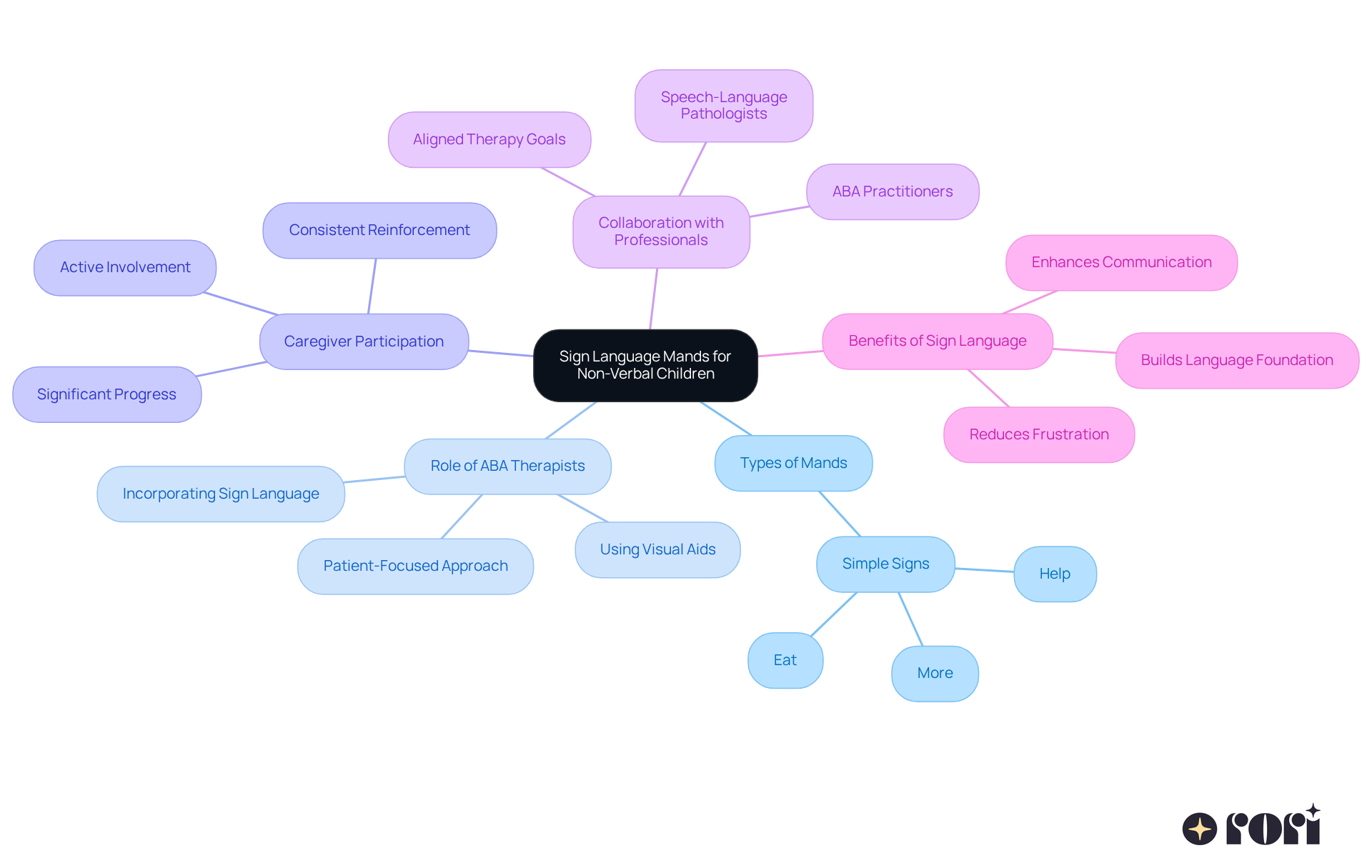
The Picture Exchange Communication System (PECS) is a fantastic tool for helping kids express their needs through visual supports. It really aligns with Rori Care's dedication to personalized planning and evidence-based strategies. Imagine a young person showing a picture of a cookie to ask for one—how empowering is that? It’s all about helping them advocate for themselves! At Rori Care, our ABA therapists guide kids through the structured stages of PECS, starting with simple exchanges and gradually building up to more complex interactions. This way, we can address each child's unique strengths and challenges.
Research shows that PECS can significantly boost expressive abilities in kids with autism. A meta-analysis found that children using PECS made small to moderate improvements in expressing their needs, with many quickly learning to use images for communication. In fact, around 46% of kids see positive results after just one year of PECS training! That’s pretty impressive and highlights how effective it can be for improving functional interactions. This fits perfectly with Rori Care's goals for behavior change and skill development, giving us a clear way to track progress.
But the benefits of PECS go beyond just communication; it fosters independence and self-advocacy. By using visual aids, kids not only get better at expressing their wishes but also gain confidence in their interactions. This empowerment is crucial for their overall growth, encouraging social involvement and reducing frustration when it comes to communication barriers. To make sure PECS is working effectively, Rori Care keeps a close eye on each child's progress through regular assessments. We adjust treatment plans based on the data we gather, reflecting our commitment to personalized care.
Overall, PECS stands out as a promising approach for teaching kids with autism how to communicate their needs through different types of mands. It really showcases Rori Care's dedication to adaptive strategies and ensuring every child’s success. Our clinical leadership team plays a key role in overseeing these individualized plans, making sure they meet the diverse needs of each young person. Let’s explore this together and see how we can support your child on their journey!
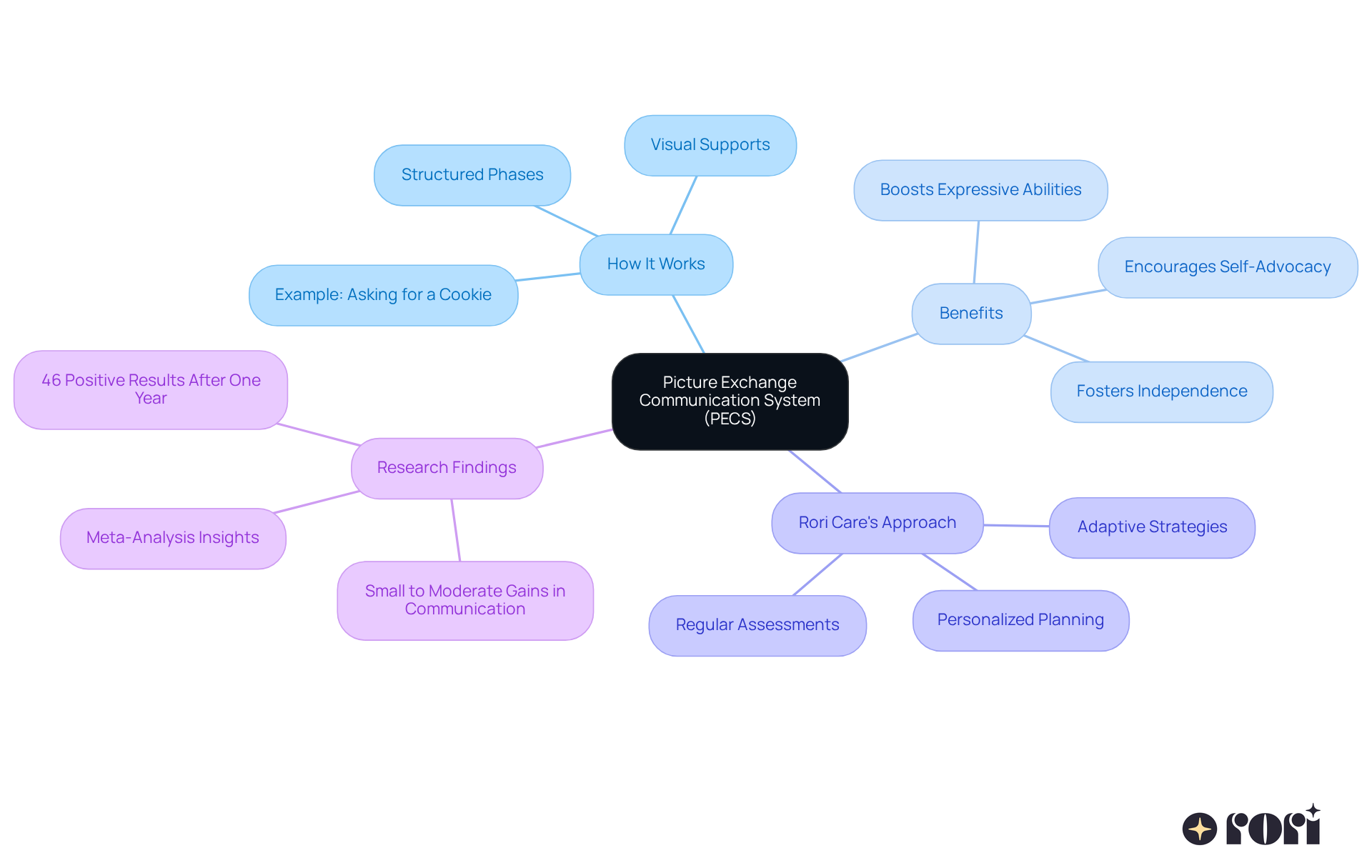
The types of mands play a crucial role in helping kids, especially those with autism, develop their interaction skills. They give children types of mands to express their needs and desires, which is so important for building social connections and independence. When caregivers focus on the types of mands training, they can really boost a young person's communication skills, leading to better social interactions and less frustration.
You might find it interesting that studies show kids who get effective instruction on types of mands often form stronger social bonds and gain more independence in their daily activities. Just think about it: when a child can use different types of mands to ask for what they need or request help, it not only empowers them but also builds their confidence in engaging with others.
Plus, long-term studies have found that good training in types of mands is associated with better academic performance and fewer behavioral issues. This really highlights how vital types of mands are in early intervention strategies! By incorporating targeted mand training and working alongside professional programs, like Rori Care's social skills group therapy, caregivers can help their kids develop meaningful conversations that involve different types of mands and connect with the world around them.
To make the most of types of mands training, it’s very beneficial for caregivers to participate in their child’s learning journey. Seeking out educational resources that explain ABA principles can really enhance understanding. Let’s explore this together! We’re here to help you every step of the way!
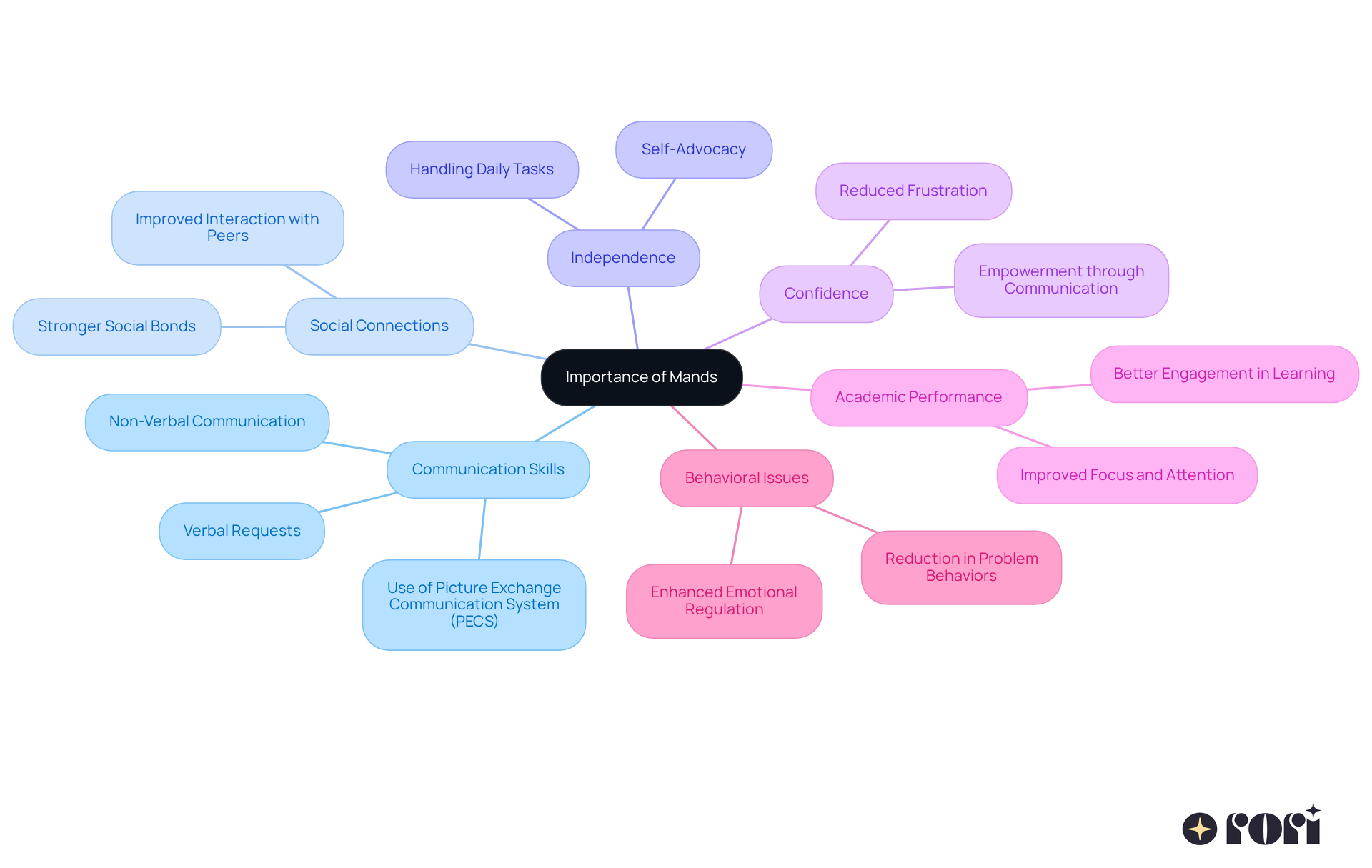
Broadening the use of requests is so important for helping kids apply their interaction skills in different places and with various people. Imagine a child being able to ask for a snack not just at home, but also at school or during playdates! Studies show that once kids learn to make requests, they can transfer those skills to new settings 67% to 80% of the time, which really boosts their communication abilities.
ABA therapists play a key role in this journey by guiding kids through the types of mands practice in various environments and with different caregivers. Using consistent reinforcement techniques in these settings helps strengthen their skills, ensuring that kids can confidently express their needs no matter where they are.
Effective training programs for types of mands should be tailored to focus on each child's interests and strengths. This approach not only promotes meaningful interactions but also helps reduce frustration. By weaving requests into daily activities, kids get practical chances to refine their skills, leading to better social interactions and greater independence.
Let’s explore this together! By encouraging your child to practice their requests in everyday situations, you’re setting them up for success!
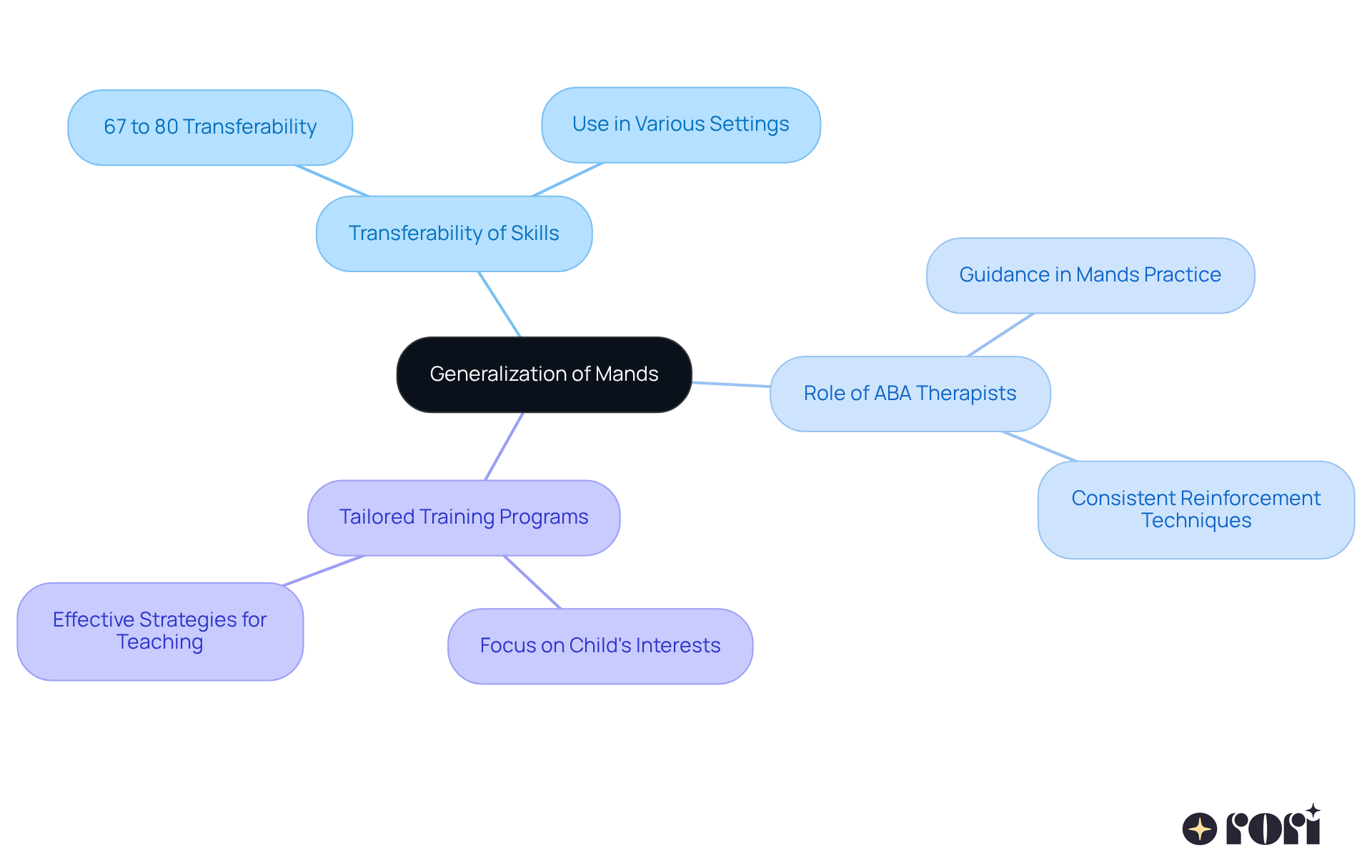
Reinforcement strategies are so important for encouraging young ones to use their communication skills, especially when we think about the principles of Applied Behavior Analysis (ABA). Positive reinforcement—like a cheerful compliment or giving access to a favorite toy—can really motivate kids to express themselves more often. For instance, when a child successfully uses a verbal request to ask for a toy, giving them that toy right away along with some enthusiastic praise not only reinforces that behavior but also makes them want to do it again!
Mixing things up with different types of reinforcers—like tokens, fun activities, or social interactions—can keep kids engaged and excited about communicating. It’s all about making the learning experience enjoyable and effective! Research shows that kids who get consistent reinforcement not only boost their expressive skills but also build confidence in sharing their needs, which leads to better social interactions overall.
When it comes to personalized planning, qualified behavior analysts are key in crafting tailored reinforcement strategies that fit each child’s unique needs. Plus, replacing unwanted behaviors with positive requests helps kids feel more in control of their communication. Visual supports, such as picture exchange systems or sign language, can also encourage kids to use various types of mands consistently.
It’s super important to empower caregivers with ABA principles and techniques to support their little ones' behavioral goals. When caregivers actively get involved and collect data, it can really enhance how effective these reinforcement strategies are. Integrating Functional Communication Training (FCT) with types of mands can enhance effective communication strategies, and gradually fading prompts helps kids become more independent in making requests.
Educating caregivers not only boosts their support and decision-making skills but also leads to better behavioral outcomes, enabling them to assist those in their care more effectively. Children with Autism Spectrum Disorders, ADHD, and other behavioral challenges can especially benefit from these strategies. Let’s explore this together and see how we can make a difference!
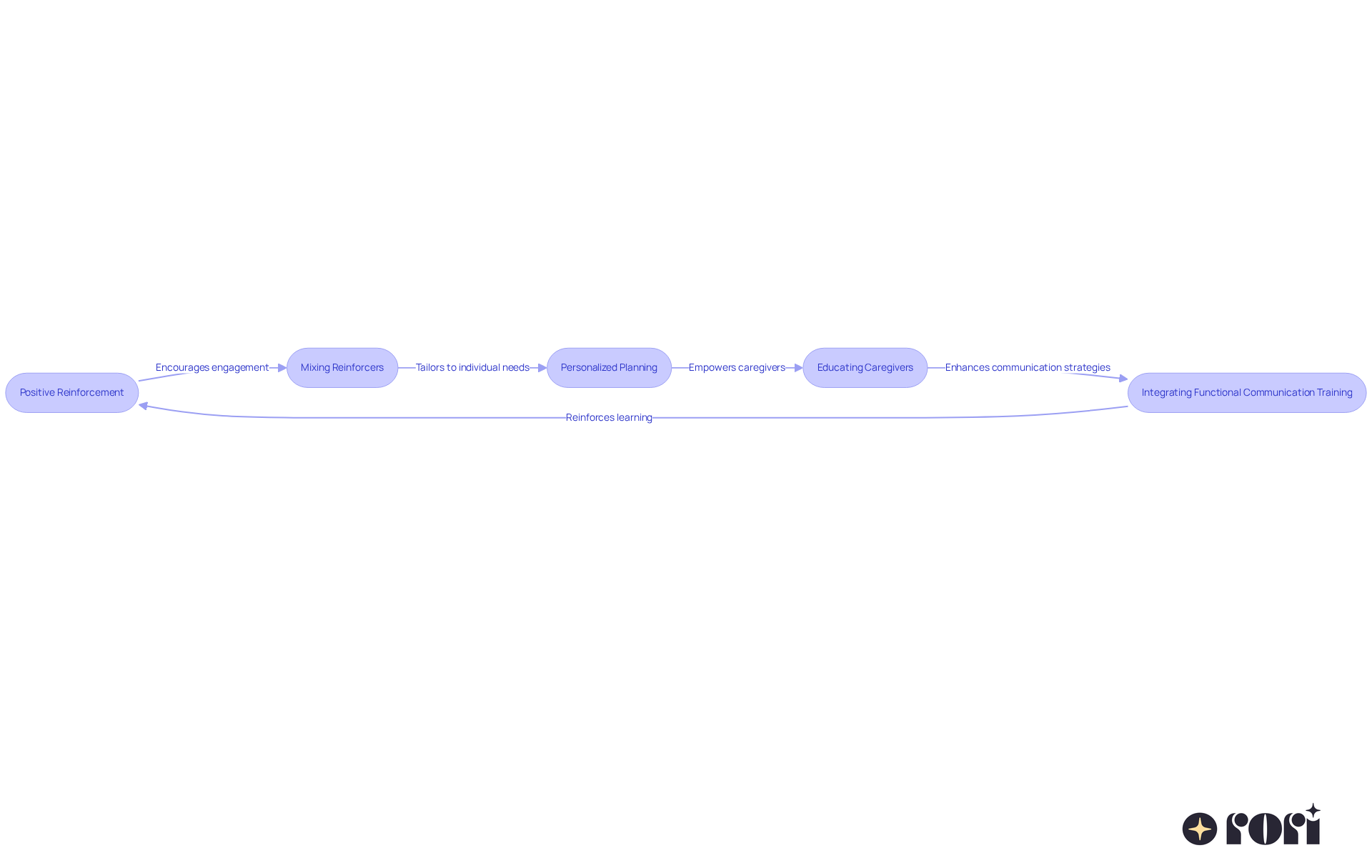
Parents play a crucial role in boosting their kids' skills in the types of mands, and it can be done effortlessly in everyday life! Simple things, like modeling requests during playtime or using visual aids like Picture Exchange Communication Systems (PECS), can create fantastic chances for little ones to practice their communication skills. Encouraging kids to express their needs during meals or outings not only reinforces their types of mands but also helps them become more independent.
Research shows that when parents actively engage, it really helps with language development and long-term success for kids with autism spectrum disorder (ASD). For instance, when caregivers consistently support successful requests—like offering a snack when a child points—it helps them understand that their appeals work, which encourages them to keep trying different types of mands to communicate. Plus, practicing requests in different settings—like at home, in stores, or during family gatherings—helps kids generalize their expressive skills across various situations.
By getting involved in their kids' communication journey, parents can create a warm environment that nurtures growth and confidence in expressing their needs. So, let’s explore this together! We’re here to help you every step of the way!
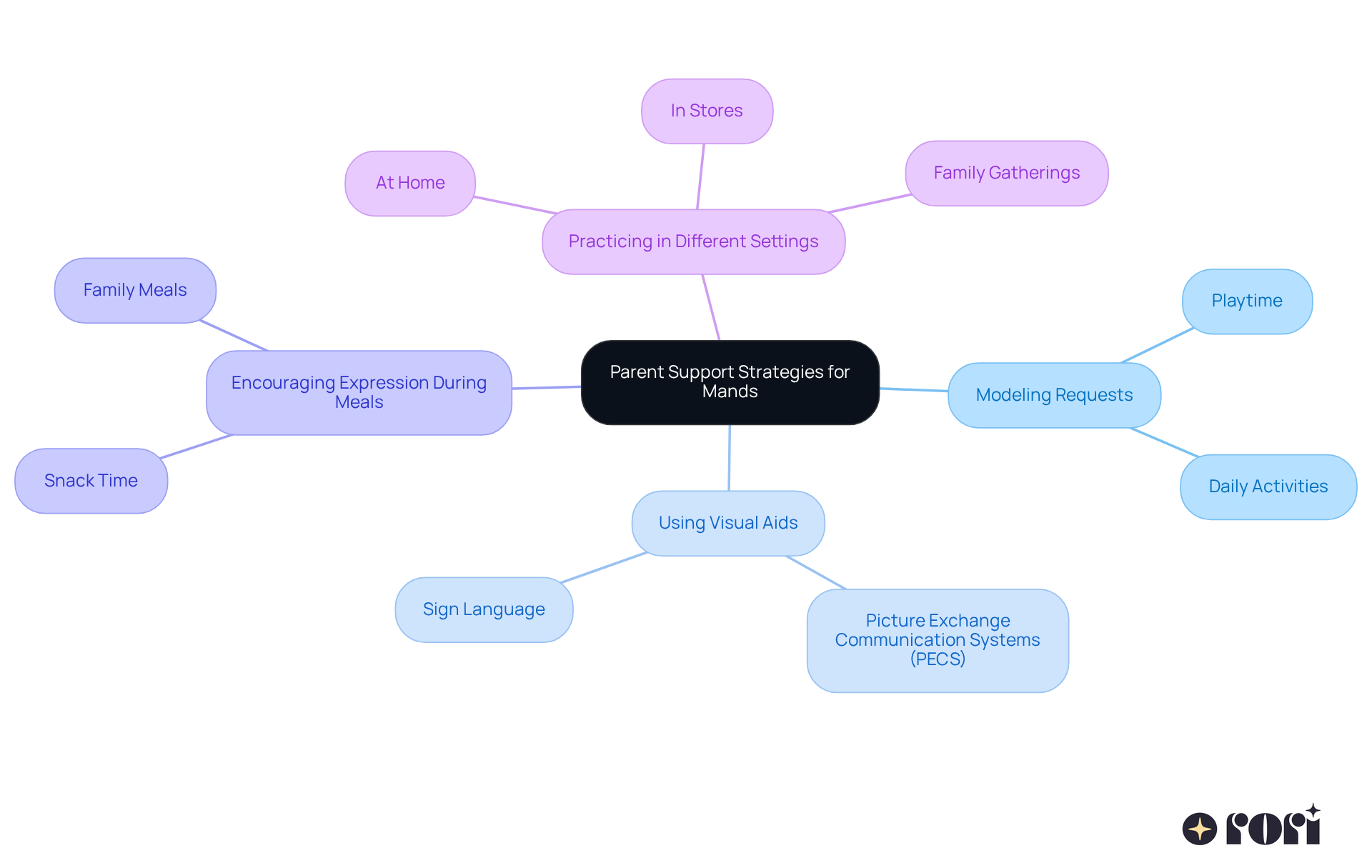
Mand training can be quite a journey for parents, especially when young ones are a bit shy about communicating or struggle to generalize their skills. It’s important to create a supportive atmosphere that encourages open dialogue without any pressure. For example, if your child is hesitant to use verbal mands, starting with non-verbal cues or visual supports can really help boost their confidence.
Engaging in fun activities that require interaction can also motivate kids to improve their skills in a relaxed setting. Working alongside ABA therapists to customize strategies based on your child’s unique needs can lead to effective solutions, making the training process both enjoyable and productive. By focusing on these approaches, you can significantly enhance your child’s verbal skills while nurturing their sense of independence.
Plus, when you empower yourself with ABA principles and strategies, you’re making informed choices that can lead to better behavioral outcomes and provide stronger support for your child’s growth. A practical tip? Consider setting aside specific times each day for communication practice. Making it a fun and consistent part of your routine can work wonders! Let’s explore this together!
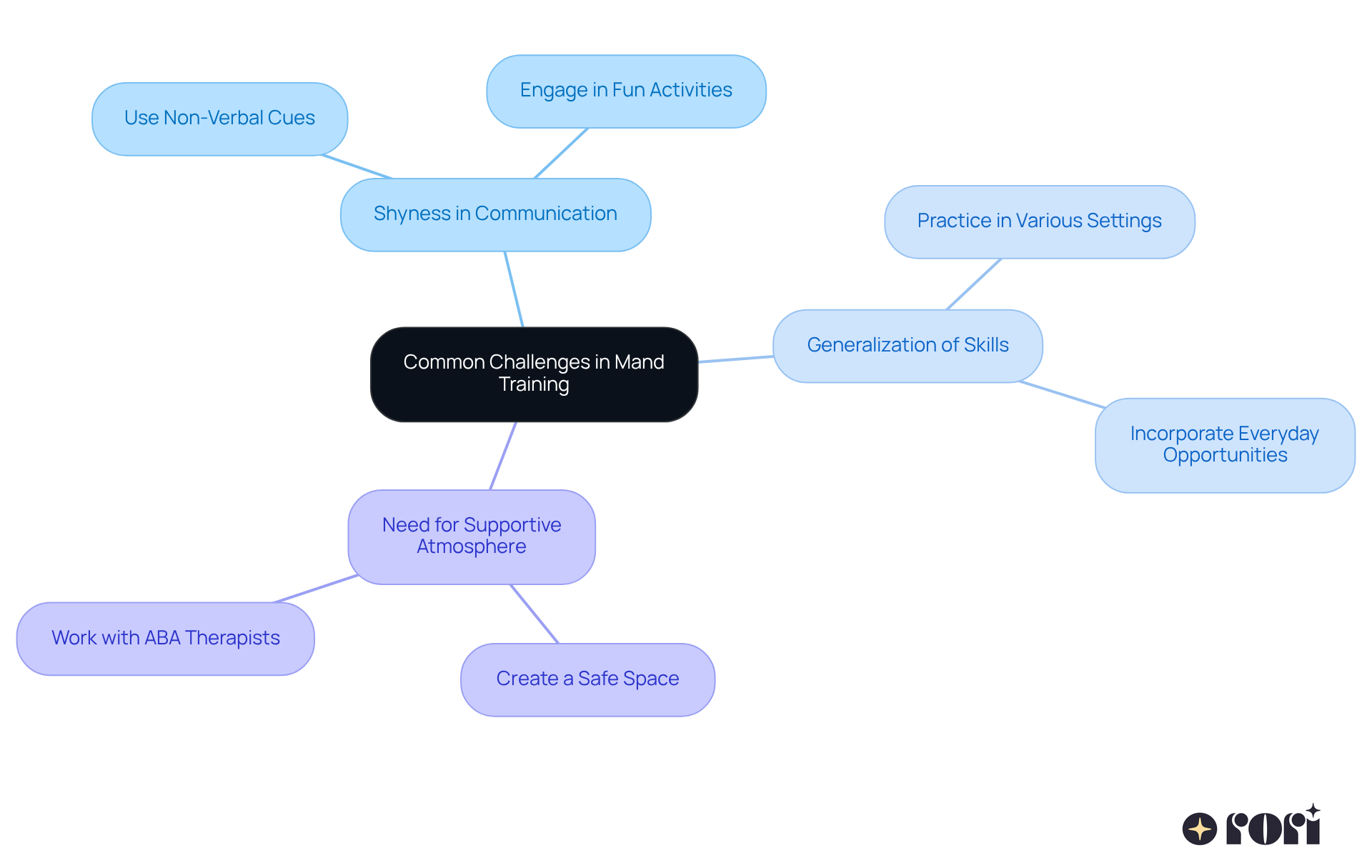
Understanding the different types of mands is key to boosting communication skills in children, especially those with autism. By focusing on mand training techniques, caregivers can help children express their needs and desires more effectively. This not only fosters independence but also reduces frustration. It’s amazing how a structured approach can enhance both verbal and non-verbal communication, building confidence and allowing children to engage more meaningfully with their world.
Throughout this article, we’ve highlighted some key strategies like verbal mands, non-verbal communication, sign language, and the Picture Exchange Communication System (PECS). Each of these methods supports children in expressing their requests, whether through spoken words, gestures, or visual aids. Plus, the role of caregivers and therapists in providing reinforcement and encouragement is so important for making sure these skills are practiced and generalized in different settings.
Ultimately, prioritizing mand training is essential for nurturing effective communication in children. By actively participating in your child's learning journey and using effective strategies, you can create a supportive environment that promotes growth. Embracing these techniques not only enhances communication skills but also opens the door to more fulfilling social interactions, contributing to your child's overall development.
Let’s explore this together! Remember, you’re not alone in this journey, and we’re here to help you every step of the way!
What is mand training in ABA therapy?
Mand training in ABA therapy involves teaching children to express their needs and wishes through requests, which helps improve their communication skills and reduces challenging behaviors.
How does mand training benefit children with autism?
Mand training helps children with autism communicate their needs more effectively, promoting independence and reducing frustration, which can lead to a more fulfilling communication experience.
What types of mands are taught in ABA therapy?
The types of mands taught in ABA therapy include item mands, action mands, location mands, and person mands, all of which aid in developing effective communication strategies.
What role do verbal mands play in ABA therapy?
Verbal mands encourage children to use spoken language to make requests, with techniques such as modeling and prompting used to help them vocalize their needs.
How is reinforcement used in teaching verbal mands?
Reinforcement involves providing immediate positive feedback or access to desired items when a child successfully uses a verbal request, which strengthens the behavior and encourages further verbal interaction.
What is discrete trial training (DTT) in the context of mands?
Discrete trial training (DTT) is a method used to teach requests by breaking skills into manageable steps, making it easier for children to learn how to communicate effectively.
How do non-verbal mands support communication for children with autism?
Non-verbal mands, such as gestures and body language, are crucial for children who struggle with verbal communication, allowing them to express their needs without words.
What impact does non-verbal mand training have on children?
Non-verbal mand training can significantly increase a child's ability to make independent requests, enhancing their initiation and response rates in communication.
How can caregivers support their child's mand training?
Caregivers can support their child's mand training by recognizing and responding to non-verbal requests, which builds the child's confidence and engagement in communication.
Why is ABA therapy considered a scientifically proven treatment for autism?
ABA therapy is the only scientifically proven treatment for autism that is covered by insurance, allowing families to access effective support without financial stress.